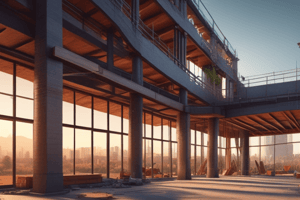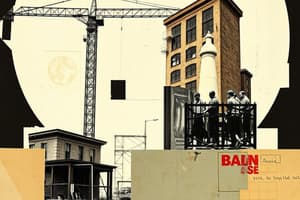Podcast
Questions and Answers
_______ is matter having unique qualities by which it may be categorized.
_______ is matter having unique qualities by which it may be categorized.
Materials
Building materials are types of materials used in constructing a _______.
Building materials are types of materials used in constructing a _______.
building
_______ are distinctive attributes or quality of material used in building construction.
_______ are distinctive attributes or quality of material used in building construction.
Properties
Physical properties are physical attributes or appearance of a building material that can be measured without changing the material, such as color and _______.
Physical properties are physical attributes or appearance of a building material that can be measured without changing the material, such as color and _______.
Pores are tiny holes or form of openings on the surface or within the material that water may pass through due to _______ action.
Pores are tiny holes or form of openings on the surface or within the material that water may pass through due to _______ action.
Porosity = 100 x volume of pores/bulk volume. Porosity = 100 x solid density – bulk density/ solid density. Example: Bricks, concrete, and timber are ______ materials. Wood is a hygroscopic material.
Porosity = 100 x volume of pores/bulk volume. Porosity = 100 x solid density – bulk density/ solid density. Example: Bricks, concrete, and timber are ______ materials. Wood is a hygroscopic material.
Density = mass (in kg)/volume (in m3). Bulk density – overall density of a material includes any air present in the gaps between particles. Solid density – density only of the solid material without air pockets. Example: Glass has 2520 Kg/m3 bulk density. Steel has 7850 Kg/m3 bulk density. Aerated concrete has 320 to 700 Kg/m3. Physical change – the material changing its state of matter without undergoing any chemical change. Example: Steel has a high melting point of 2500degrees Celsius, changing from solid to molten. MECHANICAL PROPERTIES – qualities of a building material that exhibit a response to applied force. Durability – is a measure of the material from wear to decay in relation to the intended use. A material is said to be durable if it remains in good condition throughout the planned lifetime of a building. Durability depends on many factors such as exposure to sunlight, presence of water, frost, chemical reaction, biological factors, and fire. Strength – capability of material to resist the forces imposed on it, esp. the ability to sustain a high stress without yielding or rupturing. Force acting on a component is measured in newtons (N). And force is caused by the earth’s gravity and it is the most important force in building. The strength of material is how much force or load it can withstand just before it fails. Strength = force applied at failure (N) Area of cross section (mm2) Types of forces acting on building components: Compressive or “squashing” forces Tensile or “stretching” forces Bending or “turning” forces Shear or “sliding” forces Safety factors – the ratio between the strength of the material and the maximum stress. Ensures that even the greatest theoretical loads stay well below the maximum load. But materials designed more than the safety factor indicates overdesign and waste of resources or increasing the cost. Ex. Mild steel (iron with low carbon steel) has a ______...
Density = mass (in kg)/volume (in m3). Bulk density – overall density of a material includes any air present in the gaps between particles. Solid density – density only of the solid material without air pockets. Example: Glass has 2520 Kg/m3 bulk density. Steel has 7850 Kg/m3 bulk density. Aerated concrete has 320 to 700 Kg/m3. Physical change – the material changing its state of matter without undergoing any chemical change. Example: Steel has a high melting point of 2500degrees Celsius, changing from solid to molten. MECHANICAL PROPERTIES – qualities of a building material that exhibit a response to applied force. Durability – is a measure of the material from wear to decay in relation to the intended use. A material is said to be durable if it remains in good condition throughout the planned lifetime of a building. Durability depends on many factors such as exposure to sunlight, presence of water, frost, chemical reaction, biological factors, and fire. Strength – capability of material to resist the forces imposed on it, esp. the ability to sustain a high stress without yielding or rupturing. Force acting on a component is measured in newtons (N). And force is caused by the earth’s gravity and it is the most important force in building. The strength of material is how much force or load it can withstand just before it fails. Strength = force applied at failure (N) Area of cross section (mm2) Types of forces acting on building components: Compressive or “squashing” forces Tensile or “stretching” forces Bending or “turning” forces Shear or “sliding” forces Safety factors – the ratio between the strength of the material and the maximum stress. Ensures that even the greatest theoretical loads stay well below the maximum load. But materials designed more than the safety factor indicates overdesign and waste of resources or increasing the cost. Ex. Mild steel (iron with low carbon steel) has a ______...
Hygroscopic means the ability of material to absorb moisture or water from the air, usually from the atmosphere. Non-Porous materials – material with no pores at all, has a porosity 0%. Example: Aluminum thin sheets are used to stop water vapor passing through. Size Density – is the mass of a unit volume of a material substance, either bulk or solid. Example: Bricks, concrete, and timber are ______ materials. Wood is a hygroscopic material.
Hygroscopic means the ability of material to absorb moisture or water from the air, usually from the atmosphere. Non-Porous materials – material with no pores at all, has a porosity 0%. Example: Aluminum thin sheets are used to stop water vapor passing through. Size Density – is the mass of a unit volume of a material substance, either bulk or solid. Example: Bricks, concrete, and timber are ______ materials. Wood is a hygroscopic material.
Durability – is a measure of the material from ______ to decay in relation to the intended use. A material is said to be durable if it remains in good condition throughout the planned lifetime of a building. Durability depends on many factors such as exposure to sunlight, presence of water, frost, chemical reaction, biological factors, and fire. Strength – capability of material to resist the forces imposed on it, esp. the ability to sustain a high stress without yielding or rupturing. Force acting on a component is measured in newtons (N). And force is caused by the earth’s gravity and it is the most important force in building. The strength of material is how much force or load it can withstand just before it fails. Strength = force applied at failure (N) Area of cross section (mm2) Types of forces acting on building components: Compressive or “squashing” forces Tensile or “stretching” forces Bending or “turning” forces Shear or “sliding” forces Safety factors – the ratio between the strength of the material and the maximum stress. Ensures that even the greatest theoretical loads stay well below the maximum load. But materials designed more than the safety factor indicates overdesign and waste of resources or increasing the cost. Ex. Mild steel (iron with low carbon steel) has a compres...
Durability – is a measure of the material from ______ to decay in relation to the intended use. A material is said to be durable if it remains in good condition throughout the planned lifetime of a building. Durability depends on many factors such as exposure to sunlight, presence of water, frost, chemical reaction, biological factors, and fire. Strength – capability of material to resist the forces imposed on it, esp. the ability to sustain a high stress without yielding or rupturing. Force acting on a component is measured in newtons (N). And force is caused by the earth’s gravity and it is the most important force in building. The strength of material is how much force or load it can withstand just before it fails. Strength = force applied at failure (N) Area of cross section (mm2) Types of forces acting on building components: Compressive or “squashing” forces Tensile or “stretching” forces Bending or “turning” forces Shear or “sliding” forces Safety factors – the ratio between the strength of the material and the maximum stress. Ensures that even the greatest theoretical loads stay well below the maximum load. But materials designed more than the safety factor indicates overdesign and waste of resources or increasing the cost. Ex. Mild steel (iron with low carbon steel) has a compres...
Physical change – the material changing its state of matter without undergoing any chemical change. Example: Steel has a high melting point of 2500degrees Celsius, changing from solid to molten. MECHANICAL PROPERTIES – qualities of a building material that exhibit a response to applied force. Durability – is a measure of the material from wear to decay in relation to the intended use. A material is said to be durable if it remains in good condition throughout the planned lifetime of a building. Durability depends on many factors such as exposure to sunlight, presence of water, frost, chemical reaction, biological factors, and fire. Strength – capability of material to resist the forces imposed on it, esp. the ability to sustain a high stress without yielding or rupturing. Force acting on a component is measured in newtons (N). And force is caused by the earth’s gravity and it is the most important force in building. The strength of material is how much force or load it can withstand just before it fails. Strength = force applied at failure (N) Area of cross section (mm2) Types of forces acting on building components: Compressive or “squashing” forces Tensile or “stretching” forces Bending or “turning” forces Shear or “sliding” forces Safety factors – the ratio between the strength of the material and the maximum stress. Ensures that even the greatest theoretical loads stay well below the maximum load. But materials designed more than the safety factor indicates overdesign and waste of resources or increasing the cost. Ex. Mild steel (iron with low carbon steel) has a ______...
Physical change – the material changing its state of matter without undergoing any chemical change. Example: Steel has a high melting point of 2500degrees Celsius, changing from solid to molten. MECHANICAL PROPERTIES – qualities of a building material that exhibit a response to applied force. Durability – is a measure of the material from wear to decay in relation to the intended use. A material is said to be durable if it remains in good condition throughout the planned lifetime of a building. Durability depends on many factors such as exposure to sunlight, presence of water, frost, chemical reaction, biological factors, and fire. Strength – capability of material to resist the forces imposed on it, esp. the ability to sustain a high stress without yielding or rupturing. Force acting on a component is measured in newtons (N). And force is caused by the earth’s gravity and it is the most important force in building. The strength of material is how much force or load it can withstand just before it fails. Strength = force applied at failure (N) Area of cross section (mm2) Types of forces acting on building components: Compressive or “squashing” forces Tensile or “stretching” forces Bending or “turning” forces Shear or “sliding” forces Safety factors – the ratio between the strength of the material and the maximum stress. Ensures that even the greatest theoretical loads stay well below the maximum load. But materials designed more than the safety factor indicates overdesign and waste of resources or increasing the cost. Ex. Mild steel (iron with low carbon steel) has a ______...
Flashcards are hidden until you start studying




